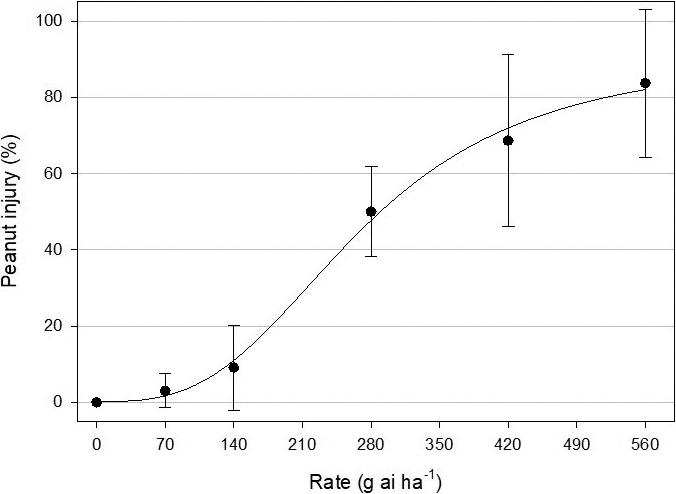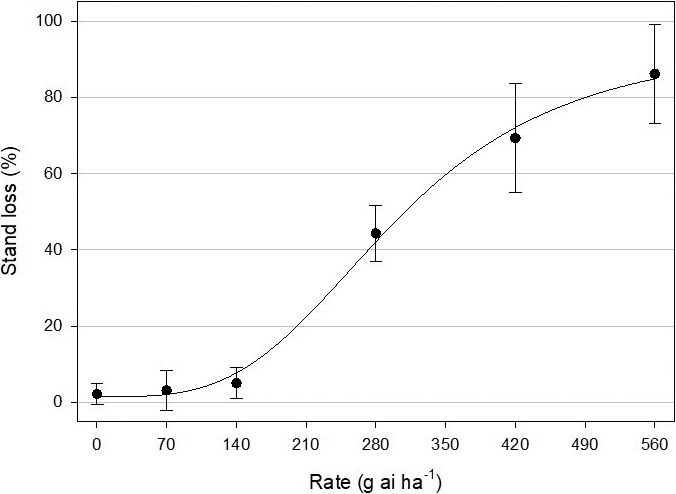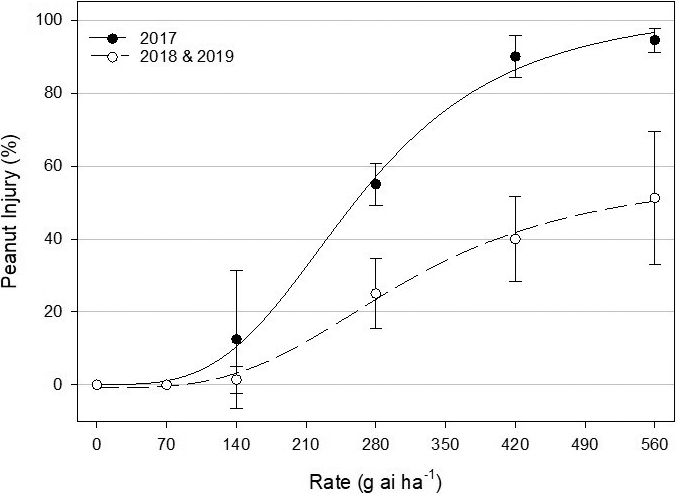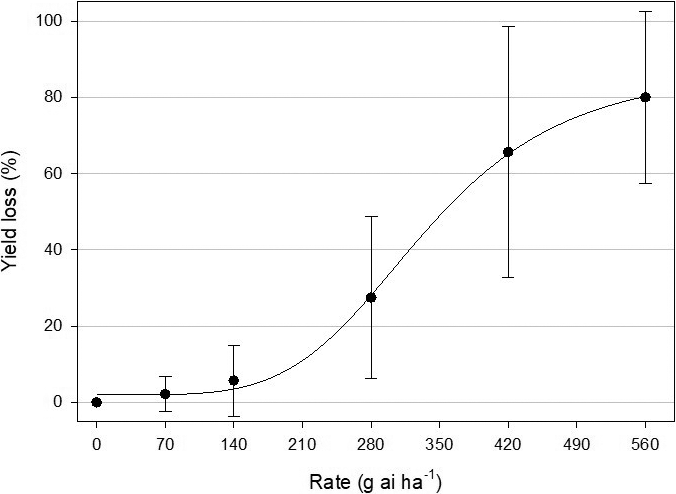Introduction
Herbicide-resistant Palmer amaranth (Amaranthus palmeri S. Wats.) is one of the most problematic weeds in the majority of agronomic crops grown in Georgia including cotton (Gossypium hirsutum L.), soybean [Glycine max (L.) Merr.], field corn (Zea mays L.), grain sorghum [Sorghum bicolor (L.) Moench ssp. bicolor], and peanut (Arachis hypogaea L.) (Webster, 2012, 2013). Palmer amaranth presents challenges to growers because of its unique biology. Palmer amaranth has an extremely wide germination window ranging from March to October, with the greatest germination occurring from June to August (Keeley et al., 1987). Furthermore, this weed is an extremely prolific seed producer with over 446,000 seed/plant produced when not competing with a crop, and over 60,000 seed/plant produced when Palmer amaranth seed were planted on August 1 (Webster and Grey, 2015; Keeley et al., 1987). Field corn harvest in Georgia typically begins in mid- to late-July and reaches its maximum in the last two weeks of August (USDA, 2010). Following corn harvest, light is then able to reach the soil surface, which stimulates Palmer amaranth germination (Jha et al., 2010). This results in a new flush of Palmer amaranth growing without any crop competition, and in many cases, these populations will go uncontrolled and contribute to the weed seed-bank, resulting in weed problems for future growing seasons. Thus, Palmer amaranth populations must be controlled following field corn harvest.
Metribuzin is a Weed Science Society of America (WSSA) Group 5 herbicide, which inhibits photosystem II at site A (Shaner, 2014). Metribuzin has an estimated half-life of 30 to 60 days, is extremely water soluble, is primarily degraded by soil microbes, and provides both postemergence and residual control of many problematic weeds, including Palmer amaranth (Crow et al., 2015; Shaner, 2014). In a study conducted to evaluate herbicide use for seed prevention in Palmer amaranth following corn harvest, tank-mixes including metribuzin applied at 263 g ai/ha resulted in little to no Palmer amaranth seed being produced (Crow et al., 2015). Another benefit of utilizing metribuzin after corn harvest is that wheat can be planted after application with no detrimental effects to yield (Crow et al., 2015).
A Federal Insecticide, Fungicide, and Rodenticide Act (FIFRA) Section 2(ee) label from United Phosphorus Limited, Inc., manufacturers of TriCor® 4F (metribuzin) herbicide, stated that TriCor® 4F could be applied at up to 280 g ai/ha in the fall, for post-harvest burndown and residual control of problematic weeds such as Italian ryegrass [Lolium perenne L. ssp. multiflorium (Lam.) Husnot], common chickweed [Stellaria media (L.) Vill.], horseweed (Erigeron canadensis L.), and Palmer amaranth in corn and soybean (Anonymous, 2015). However, rotational intervals are not listed for some of the more popular row crops in Georgia, including peanut. When consulting the label for rotational restrictions, peanut is not listed which results in an automatic 18 month rotation restriction after metribuzin is applied (Anonymous, 2014). With a targeted application date of late August to September, this would legally prevent peanut from being planted in a field where metribuzin was applied until two seasons later. Approximately 35% of the top peanut producers in Georgia rotated from field corn to peanut at least once from 2014-2017 (E.P. Prostko, unpubl. data, 2018). Metribuzin applications after corn harvest would be an extremely beneficial tool in reducing the weed seed-bank and reducing Palmer amaranth pressure in a subsequent peanut crop for these growers. However, peanut tolerance to metribuzin is not well documented. Therefore, the objective of this research was to evaluate the response of peanut to different rates of metribuzin applied preemergence to potentially assist in reducing the rotational crop interval on the current TriCor® 4F label.
Materials and Methods
Three field studies were conducted from 2017 to 2019 at the University of Georgia-Ponder Research Farm near Ty Ty, GA (31.507654 N, -83.658395 W) to evaluate peanut response to metribuzin applied preemergence at multiple rates. The soil type at the research site was a Fuquay sand (Loamy, kaolinitic, thermic Arenic Plinthic Kandiudults) with 94% sand, 2-4% silt, 2-4% clay, 0.53-0.78% organic matter, pH of 6.0, and a CEC of 2.4-3.5. Conventional tillage practices were used and ‘Georgia-06G’ (Branch, 2007) peanut was planted on April 24, 2017, April 30, 2018, and April 30, 2019. ‘Georgia-06G’ peanut is the dominant peanut cultivar planted in the southeast. In Georgia, 87% of the acres grown for certified peanut seed available for sale to growers is ‘Georgia-06G’ (Anonymous, 2020a). A vacuum planter (Monosem Precision Planters, 1001 Blake St., Edwardsville, KS 66111) was calibrated to deliver 18 peanut seed/m at a depth of 5 cm, with peanuts planted in 2 twin rows with a spacing of 90 cm by 22 cm. Plot sizes were 1.8 m by 7.6 m.
Metribuzin was applied preemergence (PRE) after planting at 0, 70, 140, 280, 420, and 560 g ai/ha. The 280 g ai/ha rate is the targeted use rate for metribuzin applications after corn harvest. Treatments were arranged in a randomized complete block design replicated four times. Herbicides were applied using a CO2-pressurized backpack sprayer calibrated to deliver 141 L/ha at 186 kPa and 5.63 km/h. Visual estimates of peanut injury (0% = no crop injury and 100% = complete crop death) were evaluated throughout the season beginning approximately 14 days after planting (DAP). Peanut stand loss was visually evaluated in 2018 and 2019 at 41 to 52 DAP, with 0% = no stand loss and 100% = complete stand loss. At the end of the season, peanut plants were inverted, allowed to air dry, and harvested 4 d later using commercial equipment (145 – 147 DAP). Peanut yields were adjusted to 10% moisture.
University of Georgia Extension peanut production recommendations were used with supplemental irrigation being applied to maximize peanut growth and development (Anonymous, 2020b). Plots were maintained weed-free using a combination of labeled herbicides and hand-weeding. Rainfall and irrigation events were documented in the first month after planting and are presented in Table 1.
Data were subjected to ANOVA using the PROC GLIMMIX procedure in SAS (SAS Institute 107 Inc., Cary, NC 27511) to evaluate year by treatment interactions; if a significant interaction was observed, data were analyzed and presented separately by year. All response variables were subjected to nonlinear regression with the intent to determine if the response could be described by the log-logistic dose-response curve, y = c+(d-c)/1+exp[b(log(x) – log I50)]. In the aforementioned equation y is the response variable, c is the lower limit, d is the upper limit, x is the rate of metribuzin (g ai/ha), I50 is the rate of metribuzin that resulted in 50% response, and b is the slope of the regression at I50 (Seefeldt et al., 1995).
Results and Discussion
Early in the season, visual injury was evaluated 29 – 52 DAP, and there was no significant year by treatment interaction. Therefore, data were pooled over year. Early season injury was regressed against metribuzin rate and fit to a log-logistic regression model (Fig. 1). Maximum peanut injury early in the season was 91% at the 560 g ai/ha rate of metribuzin. The I50 estimate for early season injury was 272 g ai/ha. Of note from early season injury data is that when rates of 140 g ai/ha or less were applied, predicted visual injury values were less than 11%. In soybeans, up to seven weeks after planting, injury from applications of metribuzin at planting was noted up to 82% (Moshier and Russ, 1981). A similar trend was observed in wheat, with up to 67% visual injury resulting from PRE applications of metribuzin (VanGessel et al., 2017). In both of the previous studies, higher application rates resulted in increased injury.
Early season visual peanut injury (29 - 52 DAP) as influenced by metribuzin rate, pooled over data from 2017-2019. Visual injury data were fitted to the following logistic response equation: Yinjury=c+(d-c)/1+exp[b(log(x) – log I50)]. Equation parameters (c, d, b, I50, R2) were as follows: 91.27, 0.2323, 3.0182, 272.1, and 0.86, respectively. Data points represent the observed means with standard error.
When relative stand loss was visually evaluated in 2018 and 2019 (41 – 52 DAP), there was no significant year by treatment interaction; therefore, data are pooled over year. Stand loss was regressed against metribuzin rate and fit to a log-logistic regression model (Fig. 2). Maximum peanut stand loss was 95% at the 560 g ai/ha rate of metribuzin. The I50 estimate for stand loss was 302 g ai/ha. Similar to early season injury data, predicted values for relative stand loss were less than 8% when rates of 140 g ai/ha or less were applied. With an optimum plant stand of at least 12.3 plants/m for peanut, the level of stand reduction resulting from the 140 g ai/ha rate is not enough to warrant replanting (Sarver et al., 2017). When evaluating soybean stand following preplant applications of metribuzin, as metribuzin rate increased, soybean stand decreased (Moshier and Russ, 1981).
Relative peanut stand loss as influenced by metribuzin rate (41-52 DAP), pooled over data from 2018-2019. Stand loss data were fitted to the following logistic response equation: Ystand loss= c+(d-c)/1+exp[b(log(x) – log I50)]. Equation parameters (c, d, b, I50, R2) were as follows: 94.95, 1.47, 3.4202, 302.3, and 0.94, respectively. Data points represent the observed means with standard error.
Late season injury (85 – 98 DAP) was significantly impacted by year by treatment interactions; therefore, data were separated into injury evaluations in 2017 and 2018 – 2019. In 2017, maximum peanut injury late in the season was 104% at the 560 g ai/ha rate of metribuzin with an I50 estimate of 264 g ai/ha (Fig. 3). Late season injury in 2018 – 2019 reached a maximum of 58% at the 560 g ai/ha rate of metribuzin with an I50 estimate of 312 g ai/ha. According to the 95% asymptotic intervals, there was no significant difference between I50 estimates for late season injury in 2017 (264 ± 35 g ai/ha) and 2018 – 2019 (312 ± 103 g ai/ha). However, the maximum level of peanut injury was significantly different between years. Late season injury in 2017 (104% ± 15.5) was significantly higher than 2018 – 2019 (58% ± 24.7). In 2017, rainfall/irrigation totals from 8-14 DAP, at or around the time of peanut emergence (VE), were higher which may have resulted in increased peanut injury (Table 1). It is very common to observe increased peanut injury from soil applied herbicides when irrigation or rainfall events occur at or shortly after the VE stage of growth (Price et al., 2004). Although maximum injury differed between years, predicted injury values of less than 11% were noted at application rates of 140 g ai/ha or less, regardless of year.
Late season visual peanut injury as influenced by metribuzin rate in 2017 (98 DAP) and 2018-2019 (85-92 DAP). Late season injury data were fitted to the following logistic response equation: Yinjury= c+(d-c)/1+exp[b(log(x) – log I50)]. Equation parameters (c, d, b, I50, R2) were as follows: 2017 (104, 0.0313, 3.4389, 264.2, 0.97) and 2018-2019 (58.05, 0.0546, 3.26, 312.3, 0.84), respectively. Data points represent the observed means with standard error.
Concerning relative peanut yield loss, there was no significant year by treatment interactions; therefore, data are pooled over year. Averaged over year, peanuts yielded 6,152 kg/ha when not treated with metribuzin. When relative yield loss was regressed against metribuzin rate to fit a log-logistic regression model, maximum yield loss was 88% at the 560 g ai/ha rate with an I50 estimate of 335.8 g ai/ha (Fig. 4). Predicted yield loss of less than 5% was noted at rates of 140 g ai/ha or less. Similar to this data, soybean yield loss was only noted at metribuzin rates that significantly reduced plant stand (Moshier and Russ, 1981).
Relative peanut yield loss as influenced by metribuzin rate, pooled over data from 2017-2019. Relative yield loss data were fitted to the following logistic response equation: Yyield loss= c+(d-c)/1+exp[b(log(x) – log I50)]. Equation parameters (c, d, b, I50, R2) were as follows: 87.81, 1.9736, 4.5664, 335.8, and 0.76, respectively. Data points represent the observed means with standard error.
Summary and Conclusions
Metribuzin rate influenced peanut injury, stand, and yield. However, rates of 140 g ai/ha or lower resulted in minimal injury, stand loss, and yield loss. With a targeted application rate of 280 g ai/ha following field corn harvest in August to September, and an estimated half-life of 30 to 60 days, minimal impacts on a rotational peanut crop planted the following late-April or early-May (> 180 days), would be expected. Based on this research, post-harvest applications of metribuzin could be useful in an integrated weed management program to prevent weed seed rain, reducing Palmer amaranth pressure in a subsequently planted peanut crop, and delaying resistance to some of the more widely utilized mechanisms of action in Georgia.
Future research should evaluate the tolerance of additional peanut cultivars, the influence of heavier soil types, and both small-plot and on-farm applications of metribuzin following field corn harvest with peanut planted the following season. Even though ‘Georgia-06G’ is grown on 87% of the acres in the southeast on very light soils with low organic matter, it is possible that other peanut cultivars may vary in their response to metribuzin and that the risk of carryover injury would be greater on heavier soil types.
Acknowledgements
The authors wish to thank Dwayne Dales, Charlie Hilton, and Tim Richards for their technical expertise.
Literature Cited
Anonymous. 2014. TriCor® 4F product label. Online. Accessed at: https://s3-us-west-1.amazonaws.com/agrian-cg-fs1-production/pdfs/TriCor_4F_Label1d.pdf
Anonymous. 2015. TriCor® 4F Section 2(ee) recommendation. Online. Accessed at https://s3-us-west-1.amazonaws.com/agrian-cg-fs1-production/pdfs/TriCor_4F_2EE1.pdf
Anonymous. 2020 a. Peanut & Soybean Buyers Guide. Georgia Crop Improvement Association. Online. Accessed at http://www.georgiacrop.com/fullpanel/uploads /files/2020-peanut—soybean-buyers-guide-rev-12-3-2019-00004.pdf.
Anonymous. 2020 b. UGA Peanut Production – 2020 Quick Reference Guide. Univ. of Georgia Ext. Annual Publication AP-118.
Branch W.D. 2007. Registration of ‘Georgia-06G’ peanut. J. Plant Regist. 1: 120.
Crow W.D., Steckel, L.E. Hayes, R.M. and Mueller. T.C. 2015. Evaluation of POST-harvest herbicide applications for seed prevention of glyphosate-resistant Palmer amaranth (Amaranthus palmeri). Weed Technol. 29: 405– 411.
Jha, P., Norsworthy, J. K. Riley, M. B. and Bridges. W. 2010. Annual changes in temperature and light requirements for germination of Palmer amaranth (Amaranthus palmeri) seeds retrieved from soil. Weed Sci. 58: 426– 432.
Keeley P.E., Carter, C.H. and Thullen. R.J. 1987. Influence of planting date on growth of Palmer amaranth (Amaranthus palmeri). Weed Sci. 35: 199– 204.
Moshier L.J. and Russ. O.G. 1981. Metribuzin injury in soybeans as influenced by application timing and cultivation. Agron. J. 73: 677– 679.
Price, A.J., Wilcut, J.W. Cranmer. J.R. 2004. Physiological behavior of root-absorbed flumioxazin in peanut, ivyleaf morningglory (Ipomoea hederacea), and sicklepod (Senna obtusifolia). Weed Sci. 52: 718– 724.
Sarver J.M., Tubbs, R.S. Beasley J.P. Culbreath, A.K. Grey, T.L. Rowland, D.L. and Smith. N.B. 2017. Evaluating plant population and replant method effects on peanut planted in twin rows. Peanut Sci. 44: 19– 25.
Shaner D.L., ed. 2014. Herbicide Handbook. 10th edition. Lawrence, KS: Weed Science Society of America.
Seefeldt S.S., Jensen, J.E. and Fuerst. E.P. 1995. Log-logistic analysis of herbicide dose-response relationships. Weed Technol. 9: 218– 227.
[USDA] United States Department of Agriculture, National Agricultural Statistics Service. 2010. Field Crops: Usual planting and harvesting dates. Online. Accessed at: https://downloads.usda.library.cornell.edu/usda-esmis/files/vm40xr56k/dv13zw65p/w9505297d/planting-10-29-2010.pdf
VanGessel M.J., Johnson, Q.R. and Scott. B.A. 2017. Effect of application timing on winter wheat response to metribuzin. Weed Technol. 31: 94– 99.
Webster T.M. 2012. Weed survey – Southern states: grass crops subsection. Pages 267 – 288 in Proceedings of the Southern Weed Science Society. Charleston, SC: Southern Weed Science Society.
Webster T.M. 2013. Weed survey – Southern states: broadleaf crops subsection. Pages 275 – 287 in Proceedings of the Southern Weed Science Society. Houston, TX: Southern Weed Science Society.
Webster T.M. and Grey. T.L. 2015. Glyphosate-resistant Palmer amaranth (Amaranthus palmeri) morphology, growth, and seed production in Georgia. Weed Sci. 63: 264– 272.
Notes
- First, second, and third authors: Graduate Research Assistant, Graduate Research Assistant, and Professor, Dept. Crop & Soil Sciences, The University of Georgia, Tifton, GA 31794. [^] *Corresponding author Email: eprostko@uga.edu
Author Affiliations






